The Actual Revenues page allows you to record all revenues the Folio generates during its execution. Revenues are added to one of two main Categories: Operating revenues or non-operating revenues. Revenues can be single occurrence or recurrent. Consulting revenues are revenues earned from providing or performing consulting services, such as developers, testers, team leads, coaches, etc. and are added to the operating revenues. Information entered here will be used to provide project profitability metrics on the Overview page and will be shown on the Forecast charts.
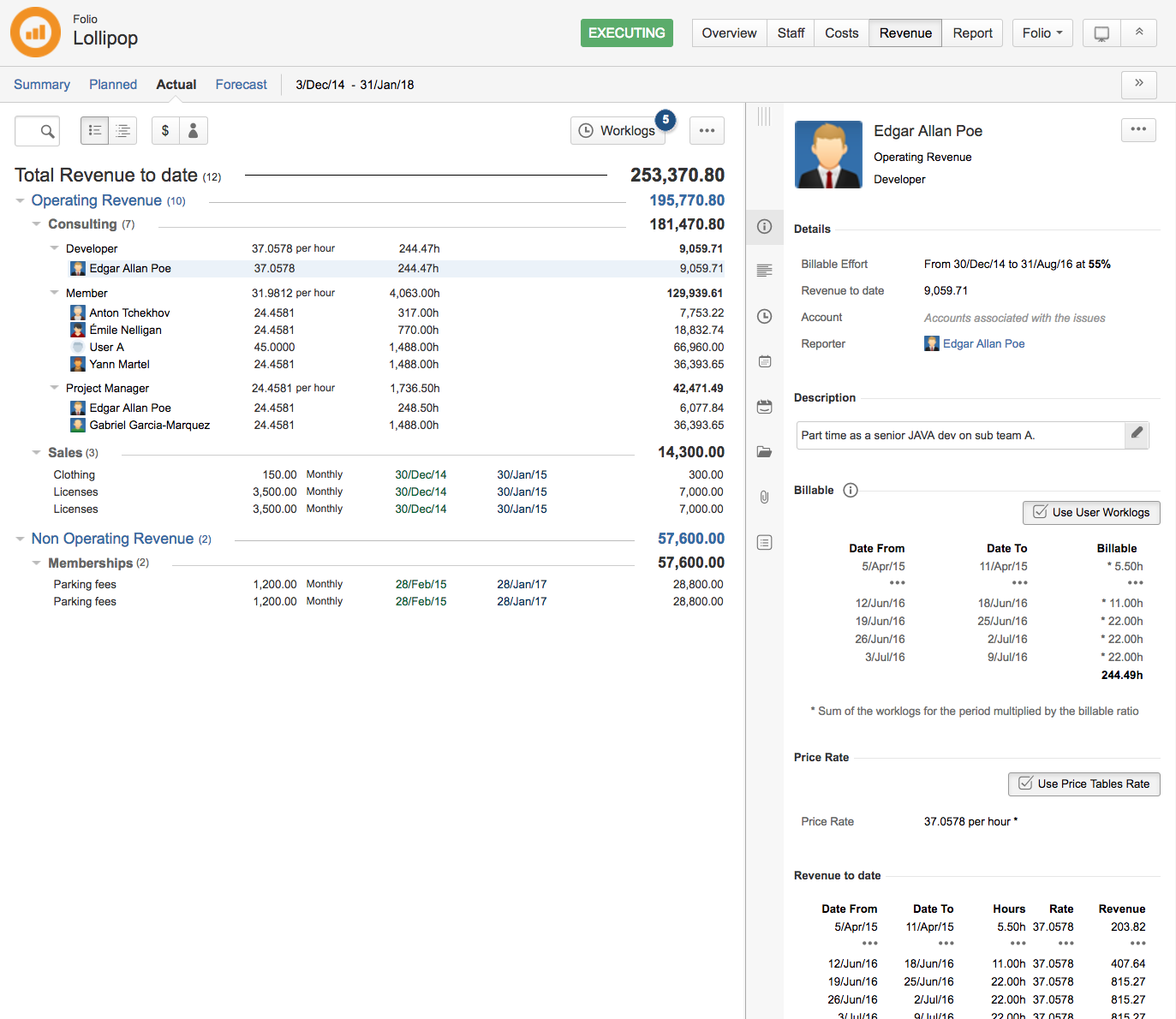
Non-Consulting Revenues
Non-consulting Revenues include all amounts earned from other sources then billed worked hours while executing the Folio. They belong to one of two categories. Non-consulting Revenues can be single occurrence or recurrent ones. Recurrent revenues can also be amortized; in which case the amount associated with the revenue will be evenly split over the earned period.
See Non-Consulting Revenues for more information.
Adding a non-consulting revenue
To add a non-consulting revenue, either click the Create Revenue button or hit the a (for add) shortcut key. This brings up the edition dialog. Refer to the Editing an Non-Consulting Revenue section to learn how to fill the edition dialog. Check the Create another box at the bottom of the dialog in order to create many revenues in sequence.
Editing a non-consulting revenue
You can select edit an existing non-consulting revenue and easily modify it. In the revenue details view at the right, click the ellipsis (...) and select Edit, or hit the "e" (for edit) shortcut key to display the Update Planned Revenue dialog.
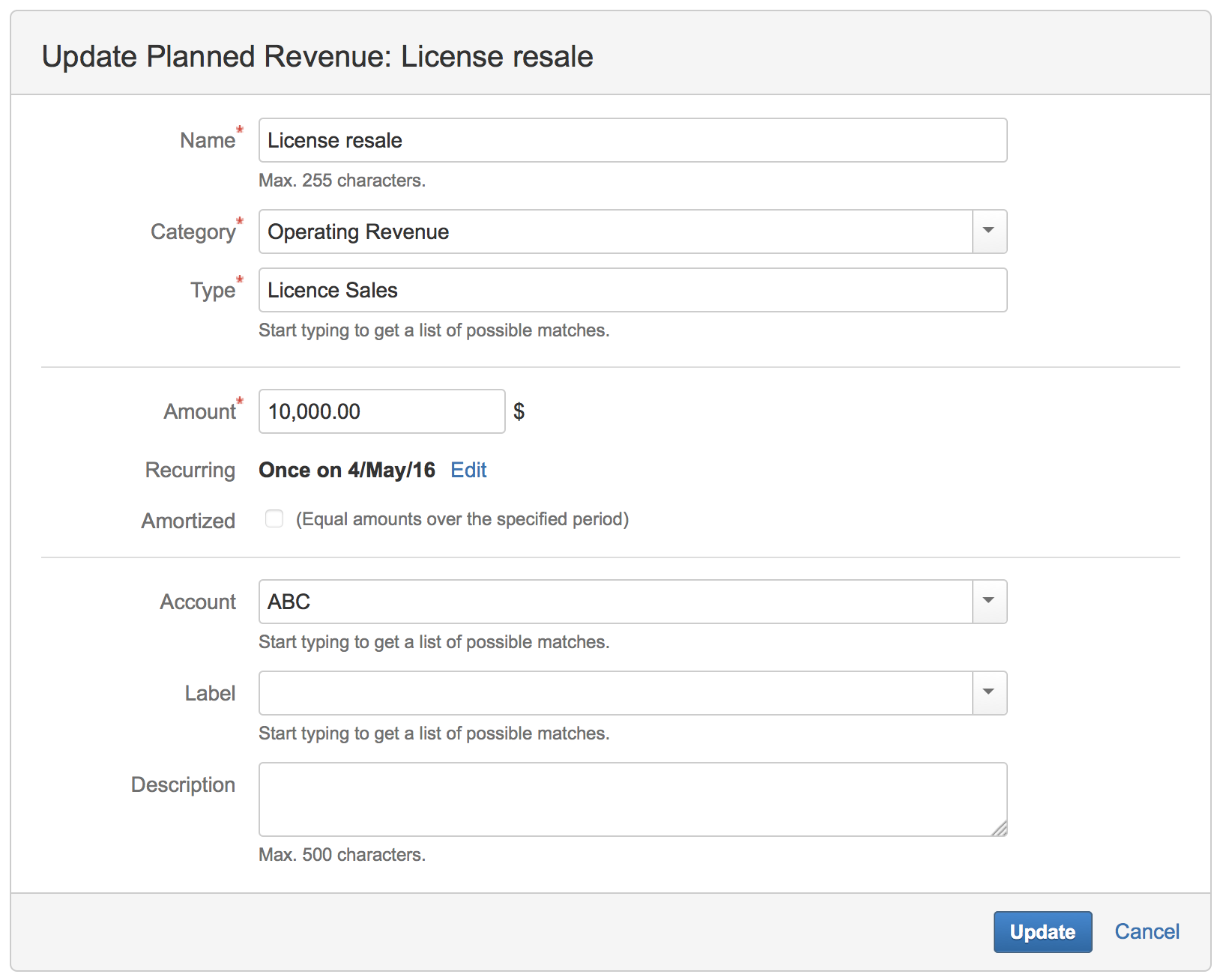
|
Name |
Name of the revenue. Examples: ABC Software License Sales, 101 Main Street, etc. |
|---|---|
|
Amount |
Amount of the revenue. Note that in the case of a recurrent revenue, the amount of the payments received for that revenue will depend if it is amortized or not. In the case of an amortized revenue, the amount will be evenly split over the number of payments defined in the recurrence definition. Otherwise, the amount of each payment is the amount entered here. |
|
Category |
Category of the revenue. See section Categories for more details on each option. |
|
Type |
Type of revenue. This gives you access to a list of pre-defined revenue types you can use to classify your revenues and for filtering in reports. You can begin typing in this field to quickly find a match, or click the drop-down arrow to select from the list. You require Tempo Account Administrator permissions to add to or edit the list of Expense or Revenue Categories (types). To access the Expense Categories (used to define expense and revenue categories) select Tempo > Settings. |
|
Recurring |
By default, a non-consulting revenue occurs on a single date. To edit the date or to make the revenue recurrent (and possibly amortized), click the Edit link to access a dialog to define the recurrence for that revenue. As you edit values in the dialog, the recurrence summary updates dynamically in the text field located immediately above. Refer to Recurrence for more details. |
|
Amortized |
Specifies if the received payments for that revenue be should split over a period of time or not. This option appears under the Recurring field when the Repeat value in the Recurrence definition dialog is changed to something else than Once. When amortized, the this revenue gets evenly split into payments occurring on dates defined in the Recurring field. |
|
Account |
Specifies the Tempo Account to associate the expense with. (optional) |
|
Labels |
Jira Issue Labels to associate the revenue with. Refer to Labels for more details. |
|
Description |
You can choose to enter a description of the revenue. |
Copying a Revenue
You can select an existing revenue to copy and then either click the ( 
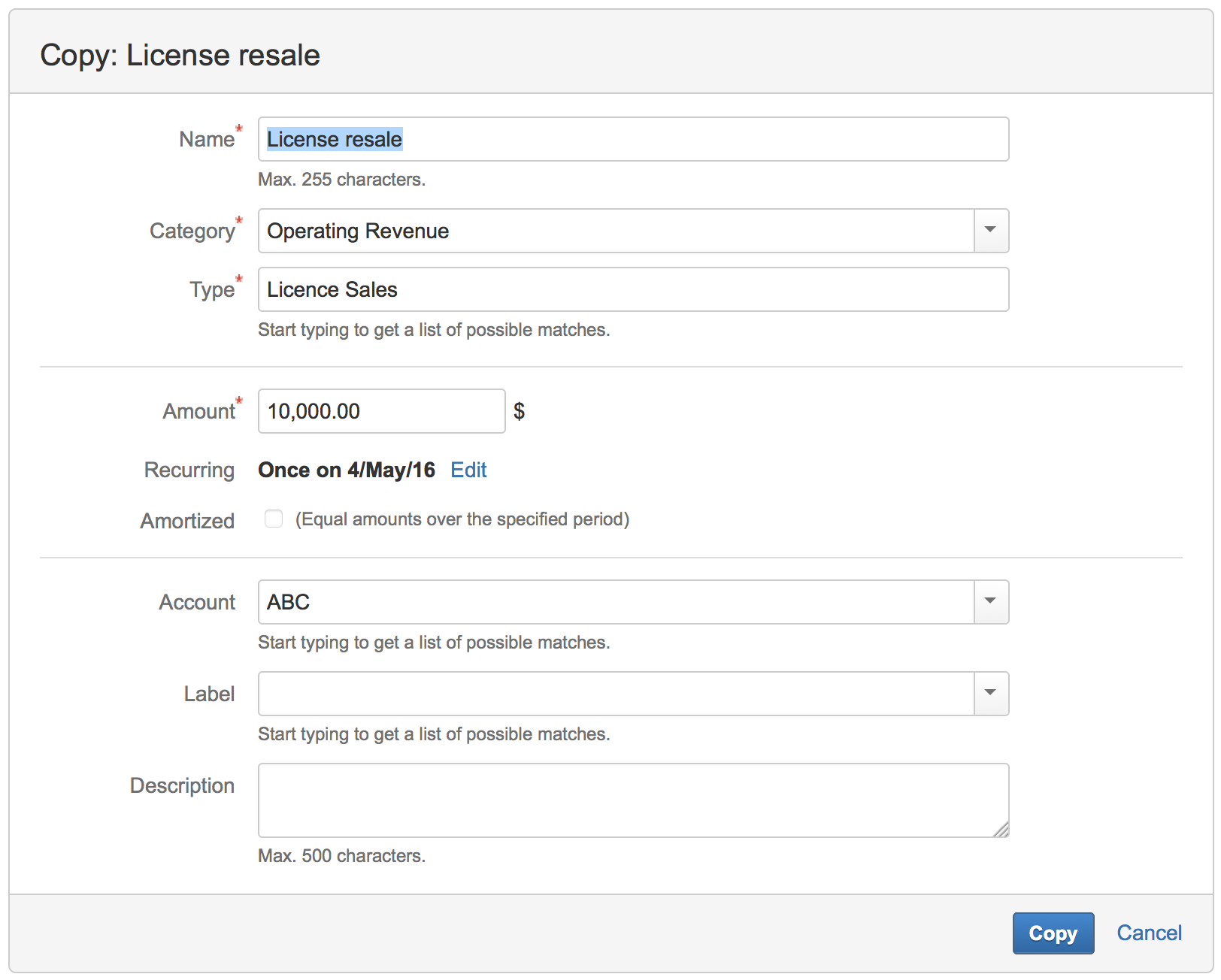
Deleting a revenue
You can select edit an existing non-consulting revenue to delete then click the ellipsis (...) and select the Delete option or hit the d (for delete) shortcut key to display the Delete dialog. Click Delete to confirm the deletion, or Cancel link to abort. Note that a deletion cannot be undone, so be sure ithat you really want to delete the revenue before proceeding.
You can delete multiple revenues at once. Refer to the Multiple Selection to learn how to perform a batch deletion.
Attaching files to a revenue
You can attach files to a revenue in order to keep related documents handy (invoices, quotations, etc.). To attach files to a revenue, select it and then click button Attach Files in revenue details panel on the right. This brings up a dialog where you can pick a file (or multiple files simultaneously, if your browser allows it) and enter an optional comment.
Viewing Revenue details
When selecting a revenue, more information on that revenue is displayed in the details panel on the right. Note that you can also select multiple revenues at once by selecting multiple lines. This provides you an aggregated view showing the total income associated with these revenues.
Searching for revenues
You can search for revenues by their name using the search box located at the top left of the screen.
Consulting History
Tempo Budgets records all changes that occur on Folios and their data for auditing purpose. When an expense, revenue or staff member is selected, the details panel shows a History sub section, quickly accessible by clicking the corresponding icon ( ![]()
The History section is visible only to users who can edit the Folio, a.k.a Folio administrators.
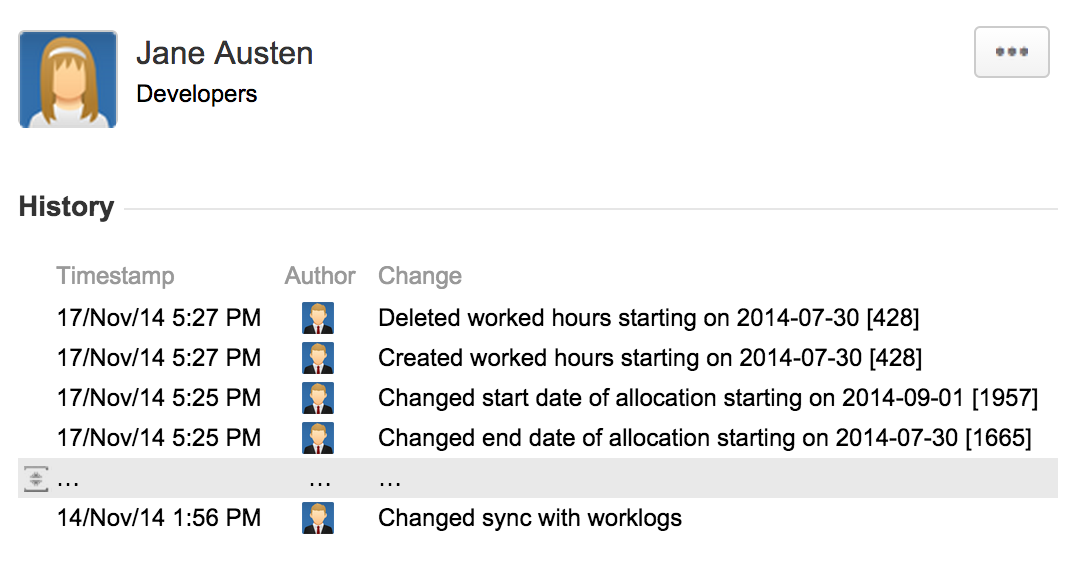
|
Timestamp |
Date and time at which the change occurred. |
|---|---|
|
Author |
Avatar of the JIRA user who performed the change. Hovering the avatar brings up a tooltip with more info on the user. Clicking it takes you to the user's page. |
|
Change |
Description of the change. It ends with the database ID of the modified item between square brackets. Hovering the description of updates brings up a tooltip showing the value before and after the change.
|
Consulting Revenues
Consulting revenues are the actual revenues from billed worked hours that the Folio generates. They are operating revenues. Consulting revenues are grouped by title (e.g. Developer, Architect, Q&A). You can collapse (or expand) a group of consulting revenues by clicking the triangle icon ( Unknown Attachment Unknown Attachment ) next to a consulting revenue role.
If using Tempo to log Billable Hours, you can configure your Folios to retrieved consulting revenues billed hours with them.
See Consulting Revenues for more information
Adding a consulting revenue
To add a new consulting revenue, either click the Create Consulting Revenue button or hit the o shortcut key. This brings up an edition dialog. Check the Create another box at the bottom of the dialog in order to create many consulting revenues in sequence.
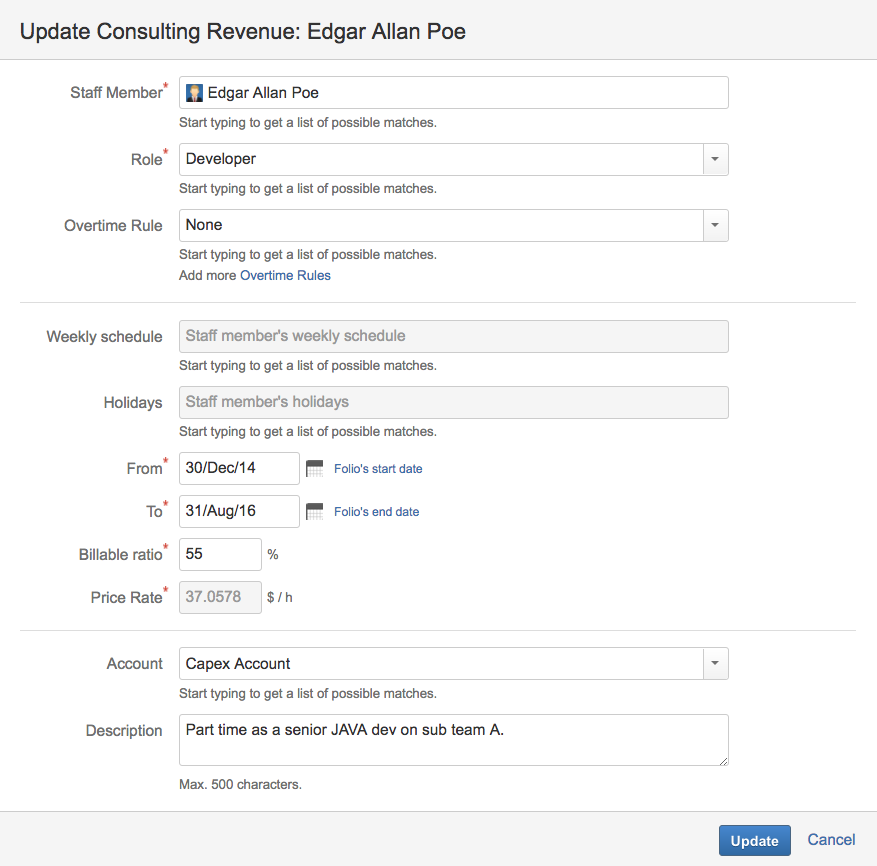
|
Team member |
JIRA user associated with this consulting revenue. The same JIRA user can be associated with many different consulting revenues, each one potentially associated to a different rate and consulting revenue role. |
|---|---|
|
Role |
Role of the resource used to classify consulting revenues. The list of valid roles is configured by JIRA administrators at the add-on level under Tempo Teams > Team Roles. Examples: Developer, Q&A, Management, etc. |
|
Overtime rule |
Overtime rule to apply to the consulting revenue. |
|
Workload Scheme |
Workload scheme to use for this consultant. NB: If the JIRA user is a Team Member of the folio then the workload scheme will be set to the team member's scheme. |
|
Holiday Scheme |
Holiday scheme to use for this consultant. NB: If the JIRA user is a Team Member of the folio then the holiday scheme will be set to the team member's scheme. |
|
From |
Date from which this consulting revenue becomes effective. |
|
To |
Date until which this consulting revenue remains effective. |
|
Billable Ratio |
Default proportion of the hours worked by the team member that are billable (and thus should automatically be converted to revenue). For example, if the JIRA user associated with the consulting revenue has worked 100 hours to date on that Folio's issues and its billable ratio is 80%, then the calculated consulting revenue to date will be 80 hours x Rate. |
|
Price Rate |
Hourly amount of money this consulting revenue generates. The rate, along with worked hours and billable ratio, determine how much revenue it has generated at a given date. If the consulting revenue is marked to Use price table rate (using the toggle button in the Price rate section of the details panel when the consulting revenue is selected If the consulting revenue is not marked to use price table rate (when the Use price table rate toggle button is unchecked |
|
Description |
An optional, free form description of the consulting revenue |
Editing a consulting revenue
Select an existing consulting revenue to modify by clicking on it and then either click on the ... menu on the top-right part of the details view (on righthand side of the screen) and select the Edit option or hit the e (for edit) shortcut key. This brings up the edition dialog. For a detailed description of the edition dialog, refer to Adding a consulting revenue section.
Custom Fields
If you have Custom fields defined in the Folio configuration, those will be show in the edition dialog box when creating or editing a revenue.

Custom field accept values of up to 255 characters. Custom field values are displayed in the details column under the Extra Information section.
Revenues Timeline
The Timeline View is displayed when the right part of the toggle button located at the top left of the Revenues Browser is pressed 
Timeline charts in Tempo Budgets offer various controls to navigate and focus on certain periods of time. Please refer to the Timelines page to learn more on available ways to interact with the Timeline.
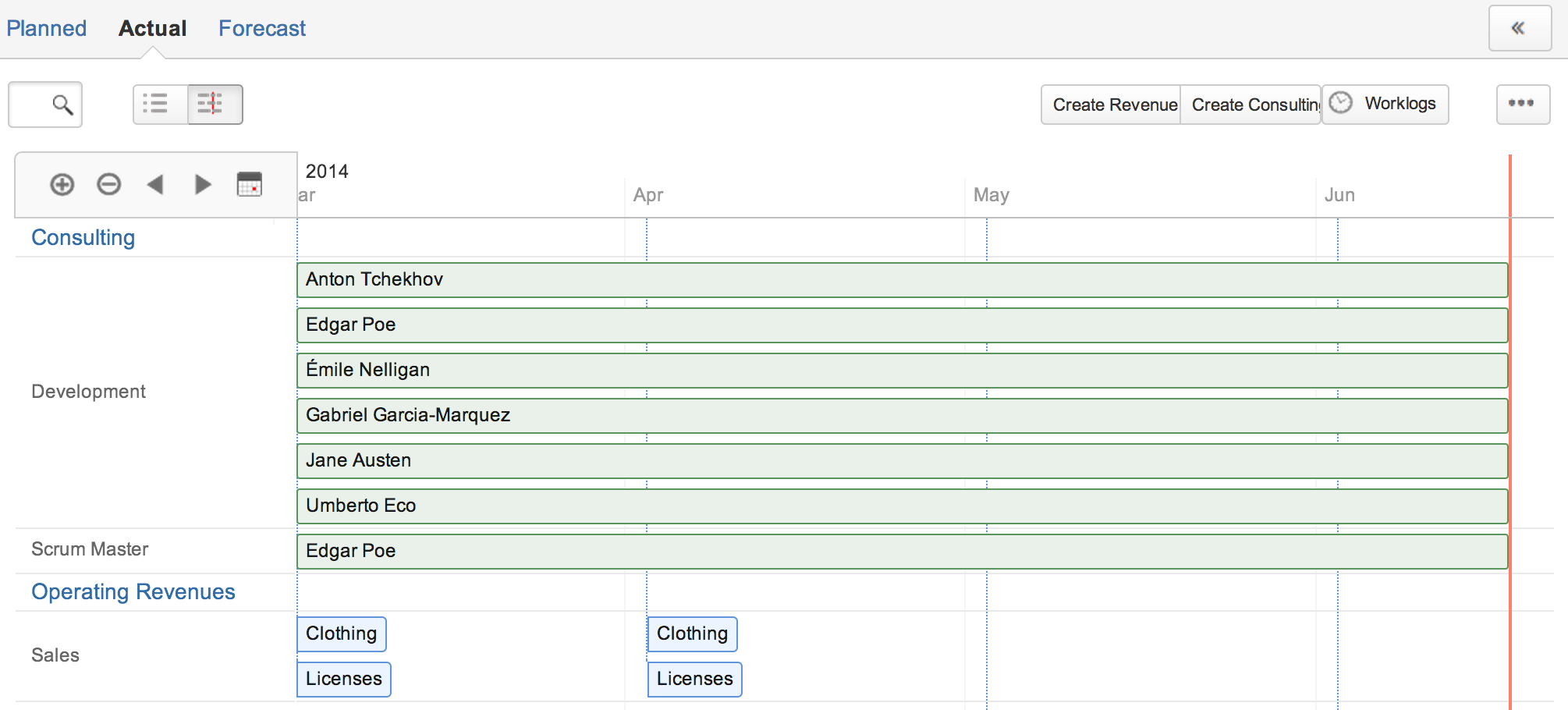
All operations described above can be executed directly from the timeline, including edition, deletion, search, multi-selection, etc.
Hovering one of the timeline elements shows the date or time period corresponding to that element as well as its summary information, such as its name and actual revenue.
Import / Export
Tempo Budgets allows you to import and export your data in CSV (comma separated values) format.

Importing Actual Revenues
To import data from an existing CSV file, click on the ... button and select Import data. Alternatively, you can type the keyboard shortcut i to open the import dialog. Please refer to Importing Data from CSV and Actual Revenues Import to learn more about importing Actual Revenues.
Exporting Actual Revenues
To export data to an external CSV file click on the ... button and select Export data. Alternatively, you can type the keyboard shortcut x to instantly export data. Exported CSV file includes all revenues information. See Actual Revenue CSV Export to learn more about exported data.
Related pages:


